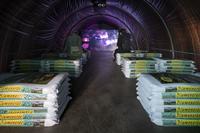Chapter 5IVE
Agrilogistics (2022)
Agrilogistics, 2022
21 minutes, video
In Agrilogistics, filmmaker Gerard Ortín Castellví examines the use of robots and visual technology in industrial agriculture and greenhouse farming in the Westland region in the west of the Netherlands. With its hyper-innovative agribusiness, the Westland is one of the most intensive agricultural areas in the world. Ortín Castellví was intrigued by the high level of mechanisation with which food is produced here, and the way in which machines exert pressure on plants to optimise the output. The crops in the greenhouse are scanned every day, to determine precisely the amount of (sellable) fruits and the state of their ripeness. In response to such data, the conditions in the greenhouse (such as the temperature or the amount of nutrition of the plant) are adjusted.
Just like Jasper Coppes (artwork number 6), Ortín Castellví uses his camera to obtain perspectives that are normally hidden from the human eye. In his case, it involves a totally regulated and repetitive environment, which was developed by humans but seems to operate fully autonomously. In his visual essay, the artist contrasts this with a scenario that is the exact opposite. In the second part of the film, escaped animals have taken over the agricultural factory, crops grow wild and untamed, straight through the roof, and the tomato robot has become part of a chaotic ecosystem.
